Baptism By Fire: 1943 // Americans In Tunisia – Part Three
March 26, 2018 by oriskany
It’s time for another chapter in this ongoing series, which takes a "wargamer's view" of the American Army in Tunisia in February and March, 1943. These would be the first large-scale ground battles the US fought against the Germans in World War II, a bloody story of harsh and painful lessons, followed by eventual redemption.
Follow The Americans In Tunisia Series
As you may have seen in Part One and Part Two, we've been using wargames like the upcoming Battlegroup Torch (IronFist Publishing) and classics like Avalon Hill’s Panzer Leader to examine these battles, looking at how the newly-arrived Americans had so much to learn from the hardened veterans of the German Wehrmacht.
So far we’ve seen where the Allies were moving against Tunisia, the last Axis redoubt in Africa, closing in from the east and west. The army moving in from the west included the American II Corps which, after failing to support the French XIX Corps against a German counterattack, were bloodily mauled at Sidi Bou Zid (14th February 1943).
Aftermath Of Sidi Bou Zid
Doubling Down On Disaster
The Battle of Sidi Bou Zid (played out with Battlegroup Torch and Panzer Leader in Part One) had been a severe shock to the US 1st Armored Division, II Corps, and the American Army as a whole. The division’s “Combat Command A” (CCA, roughly a brigade-sized manoeuvre formation) had been effectively broken as a combat-effective force.
One reason was the lack of American experience, from the individual ground soldiers, up through the NCOs, all the way to the generals at division and corps level. Major-General Ward (CO: 1st US Armored Division) had initially been out of touch, while Lt. General Lloyd Fredendall had micromanaged the division’s badly-scattered deployment.
The next day, the Americans lashed out in a series of poorly-executed counterattacks back toward Sidi Bou Zid. With 3rd Battalion / 1st Armored Regiment virtually destroyed, now 2nd Battalion was sent in, driving forward in almost perfect wedges, without infantry or artillery support, straight into German “88” fire and even Stuka air strikes.
Needless to say, these attacks accomplished little beyond depleting German ammunition supplies and cranking up the already-devastating American losses. Finally, what was left of 1st Armored Division (and the rest of II Corps) had to fall back through the town of Sbeitla, then again to Kasserine and the mountain passes beyond.
Spearheads Toward Kasserine
The Germans Press The Advantage
To understand the importance of the Battle of Kasserine Pass lets take a quick look at the topography. As laid out in previous articles, western Tunisia is dominated by two mountain chains running generally northeast to southwest, called the Eastern and Western Dorsals.
Command of the passes through these mountains is vital for any army hoping to move through (or defend) Tunisia. The German victory against the French XIX Corps at Faid Pass had given them a cut through the Eastern Dorsal, while Sidi Bou Zid and Sbeitla had given them the lowlands leading to the Western Dorsal.
Now at Kasserine, the Germans were ready to crack through the Western Dorsal. A solid breakthrough here would be disastrous for the Allies, as it would split their forces in western Tunisia, put German spearheads back in Algeria, and perhaps force an Allied withdrawal from western Tunisia altogether.
Despite being hateful rivals, the German commanders (Field Marshal Erwin Rommel and General Hans-Jurgen von Arnim) could agree that Kasserine represented a great opportunity for them. With 10th and 21st Panzer Divisions already pushed forward at Sbeitla, they were quick to reinforce and expand this attack toward the Western Dorsal.
First, they sent 21st Panzer Division north toward the town of Sbiba, where British forces of V Corps / First Army were starting to shift to help the beleaguered Americans. On 19th-20th February, 21st Panzer met with the British 1st Guards Brigade and units from US 34th Infantry Division, which checked 21st Panzer’s northward advance.
However, the British could only buy so much time. Also, Field Marshal Kesselring had taken command of this attack from General von Arnim and given it to Rommel. While von Arnim had been exceedingly cautious, Rommel (as we all know) was hardly one to let the sand gather under his boots. For the Americans at Kasserine, time had run out.
In fact, more Axis units were already on the move. To the south, elements of the old Deutsches Afrika Corps (DAK) and the Italian 131st “Centauro” Armoured Division were mobilized out of El Guettar. This spearhead had broken through near Gasfa and now headed north to meet with 10th Panzer to join in the attack through Kasserine.
Slaughter At Kasserine Pass
Operation Sturmflut (Storm Flood)
By February 19th, Rommel was ready to kick in the door at Kasserine. This would be Operation Sturmflut (Storm Flood) which, if all went well, just might open a route into Algeria and eject the Allies from western Tunisia.
Initially, Axis victory seemed a sure bet. German reconnaissance had identified only one battalion of American engineers in position, assigned to construct defensive works. These hadn’t yet been completed, and Rommel hoped to storm the disorganised defences “on the fly” while the bulk of his forces were still en route.
Unfortunately for the Germans, American reinforcements had only just arrived. These included a battalion of the 26th Infantry Regiment, a handful of tanks and more “tank destroyers” in the form of 75mm guns on half-tracks. There was even a horse-drawn battery of old French artillery.
Haphazard as it was, this tenuous defence was just enough to frustrate 33rd Panzer Recon Battalion’s bid to rush the pass. German flexibility was also hampered by the Hatab River, which was at an usually high “desert flood,” running straight down the “throat” of the pass. This made it difficult for the two wings of the German assault to support each other.
With Rommel “rolling all ones” on taking Kasserine Pass on the fly, he resolved to launch a set-piece assault. Two battalions of truck-mounted grenadiers (Kampfgruppe DAK) launched an assault on the high ground overlooking the northeast side of the pass, but this was soon bogged down and the Germans had to send in tank support as well.
Fighting continued through the day, with the Germans winding up with solid footholds on high ground dominating both sides of the pass (Djebel Chambi to the southwest and Djebel Semmama to the northeast). The Americans, now under the command of Colonel Stark, had prevented a breakthrough.
It was a long night for both sides, with opposing infantry in close contact among the jumbled rocks and jagged cuts of the pass. The Germans kept trying to slip between and around scattered American positions, and small infantry skirmishes and firefights sizzled throughout the night. Sounds like some Bolt Action games waiting to happen.
Meanwhile, the British of V Corps / First Army had been watching developments with a wary eye. If Kasserine Pass fell, their southern flank would be fatally exposed. Accordingly, Brigadier-General Charles Dunphie and the 26th Armoured Brigade) was given permission to deploy southward as a contingency against American collapse.
February 20th was a drizzly, sloppy day, but that didn’t stop Rommel from sending in a much stronger attack. Now he committed the full strength of Kampfgruppe DAK, supported by the Italian 131st “Centauro” Armoured Division, as well as what was supposed to be the bulk of 10th Panzer Division.
Here is where we run into some of the tension and rivalry between Rommel and von Arnim. Ever cautious, Arnim had held part of the 10th Panzer in reserve against large British forces to the north. In Arnim’s defence, the whole British 6th Armoured Division was up there, and Rommel’s flank was vulnerable.
Yet despite much of the 10th Panzer being missing from the assault, along with other foul-ups and misfires, the German assault smashed almost completely through Kasserine Pass. The 131st Armoured did well despite ghastly casualties, making good ground until it ran into Combat Command B of the US 1st Armored Division.
Incidentally, this engagement of elements of Kampfgruppe DAK and the Italian 131st Armoured against CCB / 1st US Armored Division is the specific battle staged in Battlegroup: Torch for this article. I wanted a chance to use more American tanks, including a rare appearance of M3 Lees, and some Italian tanks that don’t normally get on the table.
A Truly Allied Effort
General Kenneth Anderson (British First Army) had little faith in the Americans’ ability to hold the pass. After Sidi Bou Zid, who can blame him? So in addition to Dunphie’s 26th Armoured Brigade, Brigadier-General Cameron Nicholson, assistant CO of the 6th Armoured Division, was sent from the north to keep an eye on things.
Sure enough, American defence at Kasserine was starting to splinter, and German forces were soon threatening the British-held town of Thala, anchoring the southern shoulder of the British V Corps. So Nicholson took command of what British forces he had to hand, and personally led them into action.
Along the way, Nicholson gathered up other units as well - American units in reserve (waiting for orders that hadn’t come in the chaos), retreating Americans blown loose from their units, Free French infantry; anyone who had some kind of weapon and a generally “unfriendly view” toward continued German presence in Africa.
This hodgepodge battlegroup, called “Nickforce” after its commander, slammed into 10th Panzer Division’s spearheads approaching Thala. The fighting was ferocious, and at one point the Germans staged a sneak attack by using a captured Valentine tank to get close to the British defences before the ruse was discovered.
Other tank units, like the 2nd Regiment / Lothian and Border Horse Yeomanry, had to be ordered to make “forlorn hope” (i.e., death sentence) counterattacks to slow the Germans down.
But the time bought by such courage paid off. By the morning of February 21st, more American units like the 9th Infantry Division had finally sealed off Kasserine Pass. Although the Germans had largely taken it, they no longer had the strength to exploit the success.
Kasserine In Retrospect
As more American forces were drawn toward Kasserine Pass, Rommel had to admit that “Sturmflut” had failed. By February 22nd he had begun a withdrawal, with the Americans retaking the pass but in no condition to press much further.
The Americans of II Corps had been severely hammered for the second time in a week. How badly had they done? Well, depending on your definitions, they couldn’t beat the Italians in the south…and had to be rescued by the British in the north. I honestly don’t know which is worse.
Come back next week when we review the causes for Kasserine’s result, the effect on the American Army, and corrective action taken in the aftermath. Soon enough, the Americans will have a chance to redeem themselves as they meet the Germans for a third time, at a tiny Tunisian town called El Guettar.
Meanwhile, post your comments below! What do you think of the Battlegroup Torch release? Ever fancy a try at wider-scope “command tactical” wargaming? What would you have done differently at Kasserine? What’s your take on the Allies finally learning to work and fight together as a team?
Let us know below!
"...retreating Americans blown loose from their units, Free French infantry; anyone who had some kind of weapon and a generally “unfriendly view” toward continued German presence in Africa"
Supported by (Turn Off)
Supported by (Turn Off)
"Despite being hateful rivals, the German commanders (Field Marshal Erwin Rommel and General Hans-Jurgen von Arnim) could agree that Kasserine represented a great opportunity for them..."
Supported by (Turn Off)










































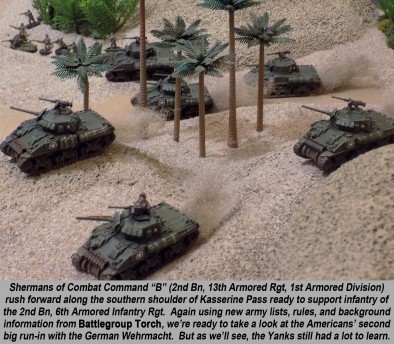


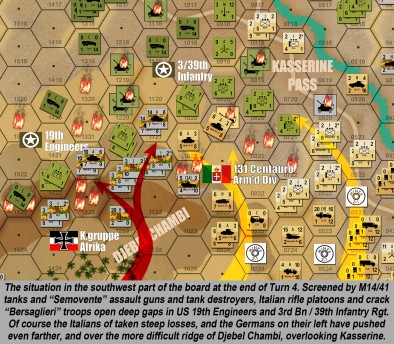
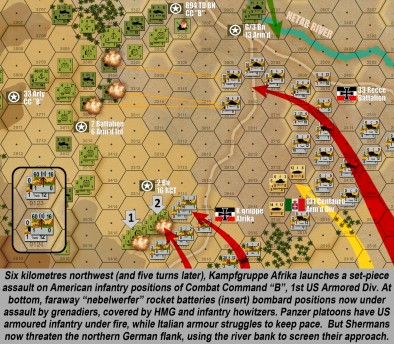
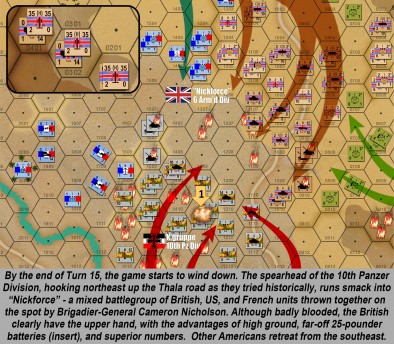
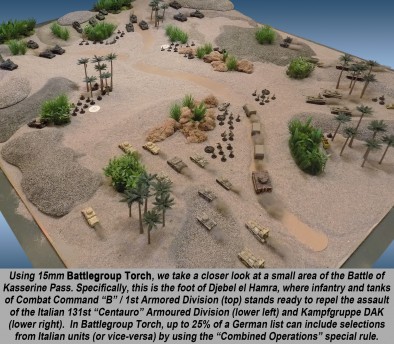
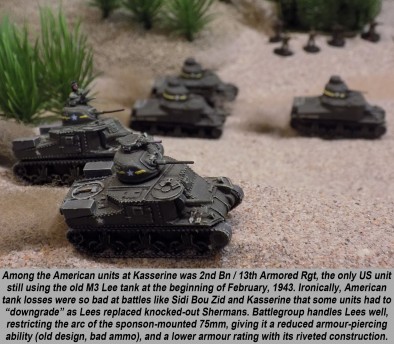

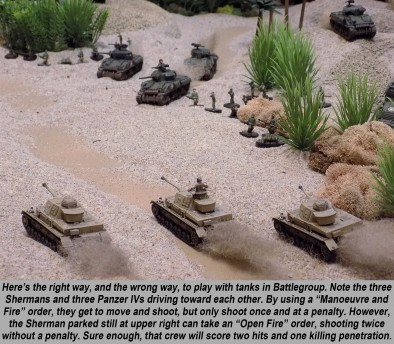


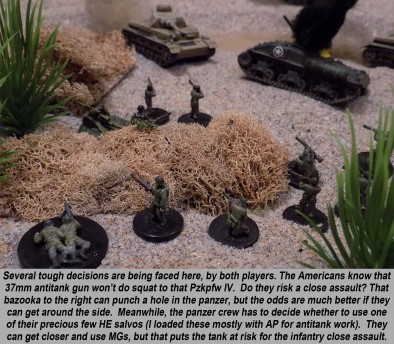
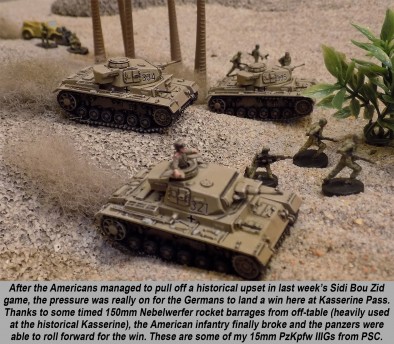




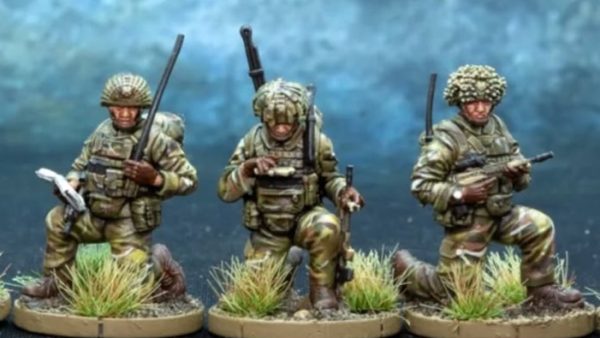





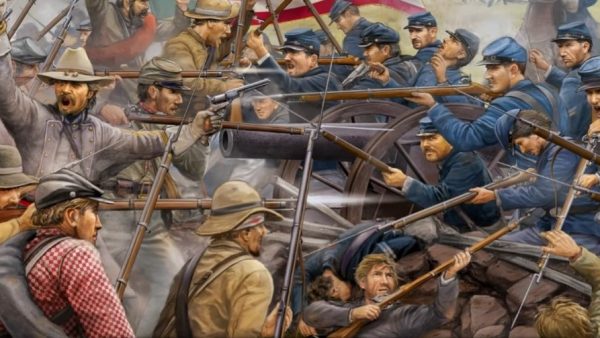























Lunch time reading. … If I can’t sneak it in before – looking forward to it
Thanks very much for kicking us off, @rasmus ! 😀 Hope you like it!
Yes, I did enjoy it – but no surprise there
Always great to hear. 😀 We always want to be ready to “change it up” if people start getting tired of a certain kind of content.
I think that the Allies dodged a bullet at Kasserine. Rommel’s initial plan for the attack was intended to shatter the allied attack in Tunisia. To quote Norman Gelb in his book ‘Desperate Venture’;
‘If he could force his way through the Western Dorsal, he would be able to reach Tebessa where a massive Allied supply base had been established. Rommel would then be in a position to thrust Northwest to the coast at Bone to cut off the British First Army and plunge deep into Algeria, driving the Allies into headlong retreat.’
His plan was confounded by two things; General von Arnim, who considered this plan reckless, he knew Allied reinforcements were moving up from Western Tunisia and the Eight Army was closing from the East. Any defeat could seal the fate of Axis forces in North Africa. Initially he refused to release forces to assist Rommel, planning to use them for probing and spoiling attacks to disrupt Allied moves.
Secondly, Rommel’s plan was modified by the Comando Supremo, the Italian High Command in Rome, who Rommel and von Arnim were technically subordinate to; instead of a wide out-flanking manoeuvre to the Northwest, they instructed the attack to go North, straight towards Thala and Le Kef, General Anderson, the British First Army commander, had concentrated a large part of his force near Thala. This would have caused Rommel serious problems.
With the lack of support from von Arnim, Rommel’s initial attack on the 19th of February wasn’t the concentrated onslaught that Rommel initially planned to break the line, if the 10th Panzer had been in the line on the 19th, I think Kasserine would have been part of a much larger set-back.
As one British newspaper put it;
‘The American troops have bought their experience at some cost, but they had to buy it someday and might well have paid more for it.’
Okay, @damon – time for a proper reply:
I think that the Allies dodged a bullet at Kasserine.
Definitely agree. They’d already broken through the Eastern Dorsal at Faid Pass and across the broken low ground beyond at Sidi Bou Zid, then broken (badly) the American counterattack at Sbleita. A solid breakthrough at Kasserine (Western Dorsal) puts them through to the Tebessa Gap, and back into French Algeria. The whole First Allied Army is split wide open, with British V and IX(?) Corps plit to the north from French XIX and US II Corps to the south, to say nothing of US I Corps coming up from Morocco and British Eighth Army coming up from Libya (hello Mareth Line).
To quote Norman Gelb in his book ‘Desperate Venture’; ‘If he could force his way through the Western Dorsal, he would be able to reach Tebessa where a massive Allied supply base had been established. Rommel would then be in a position to thrust Northwest to the coast at Bone to cut off the British First Army and plunge deep into Algeria, driving the Allies into headlong retreat.’
Absolutely no argument here.
General von Arnim … who considered this plan reckless … Any defeat could seal the fate of Axis forces in North Africa.
This is where you start getting into the “one the one hand, but on the other” debates.
Tactically, Rommel was right and von Arnim was too cautious. Committing the rest of 10th Panzer, including KG Reimann and possibly some of the 21st Panzer (instead of that stalled attack to the north against the British at Sbiba – one of the spoiling attacks you mention) might have scored the big breakthrough through the Kasserine-Tebessa corridor.
Operationally, von Arnim was right because he was looking at US I Corps, more of II Corps (rest of 9th US Infantry), and Eighth Army piling up on the Mareth Line like locusts on a windowpane.
Strategically it didn’t matter, Axis forces in North Africa had their “fate sealed” no matter what in the long run.
Thala presents an interesting problem. A wider flank thrust further to the west and then north, rather than a push straight northwest against Thala, might have been easier to start with. But honestly I don’t think the Germans and Italians had enough follow-on forces to form a solid “tail” to this thrusting arrow. 10th Panzer, KG DAK, 131st Armored – this makes for a great spearhead, but there’s nothing behind it. If Rommel pulls that hook, instead of cutting off Anderson, he get cut off himself when Anderson simply pushes down from Thala to Kasserine into that void Rommel has left behind him.
Rommel was very good at drawing arrows on maps. 😀 When it comes to the operational “okay, what NEXT?” – that where he’s a little overrated in my opinion. He damned near got himself cut off like this at Gazala, after all. Try to pull too big of an encirclement with too small a force and you wind up with your own force cut off behind the enemy instead of vice versa.
if the 10th Panzer had been in the line on the 19th, I think Kasserine would have been part of a much larger set-back.
Agree, doubly so if ALL of 10th Panzer (and its previous attachments as at Sidi Bou Zid) had been there as well.
Great post! These are the kind of posts I like because it gives us all a chance to kick around the material that couldn’t fit in the article!
By this point of the war, Rommel was ill and fast losing favour with Hitler, he was supposed to be heading back to Germany for convalescent leave. I think he knew that the Axis mission in North Africa was beaten. Even if his plan totally worked I don’t think it could have stopped the Allies, but would have made things a whole lot messier. You’re right, he just didn’t have the back up to make it stick. I think he tried to ‘roll a double 6’ to score points against von Arnim and re-establish his reputation.
Indeed, damon – “Rommel’s Desert War” (Stackpole – my bread and butter)
https://www.amazon.com/Rommels-Desert-War-Stackpole-Military/dp/0811734137/ref=pd_lpo_sbs_14_img_2?_encoding=UTF8&psc=1&refRID=CW4J6RXQ6N2BC6DQEKZJ
… goes a lot more into Rommel’s health problems. Jaundice, dysentery, if memory serves, years in the desert without enough water for hygiene really affected the health of many DAK troops. Rommel was no exception, by 1943 his health was basically ruined.
Another great article about a dark time for the US Army. Just promise me it gets better by the end! On a serious note, well done! 🙂
Thanks very much, @pslemon – and yes, it certainly does start to turn around, actually very quickly, once the Americans get a chance to reorganize some of their commanders, implement some changes, and train some confidence back into these badly beat-up formations.
Oh, and @damon – I promise to get to your response as well, but yours is going to take a few minutes and I’m on my way to work. I promise I haven’t “skipped” you. 😀
@oriskany ,Thanks Jim another great lunchtime reading.
The time reading it cant equate to the time it took you to write it,( I wrote a couple for Minature Wargames a few years back so I know the effort you have to put in)
God know how you find time with your normal daytime job, painting, dodging hurricanes etc.
Thanks very much, @bobcockayne – glad you liked the article. Indeed this series and the recent Tet Offensive and Saratoga series were pretty time-intensive to put together, but you know what they say – “do what you love and you never work a day in your life.”
Luckily for me I have a very serious, committed, earnest, and hard-working collaborator for the next series coming up! 😀 So looks like this old man finally caught a break!
If you’d ever fancy putting articles together for Beasts of War, I can’t recommend the experience highly enough. You get great support from Ben and Sam, as well as Lance with some of the front page graphics and Tom on web support.
Funnily enough I have an idea for an article on the ‘Battle of Snipe’ the epic rifles last stand at Alamein, we did at as a demo game for a show back in ancient times in 1/200th
That would be epic. We touched on Outpost Snipe back in Part Four of the original Desert War series two years ago, but didn’t have nearly enough space or time (or miniatures, honestly) to do it justice.
Link to article, about half way down:
http://www.beastsofwar.com/battlegroup/desert-war-ww2-north-africa-turning-tide/
Again, we barely had time to do a “driveby” on the topic. A re-visit, more in depth, might be great idea!
Not surprised you couldn’t cover it at time its an epic in it own right.
It would get Warzans juices flowing!
Oh, I covered it, @bobcockayne – just not thoroughly, and certainly not as much as it deserves to be. The epic fight for 239 battery, 76th AT regiment, reinforced by 41, 45, 47 RTRs against German 21st Panzer and Italian Littorio divisions – it could easily be a whole article in itself. 😀 Definitely familiar with the episode.
I guess this is the battle you see at the very start of “Patton,” or at least the aftereffects of it. So I’ve been told, hope I’m not too wrong. Sounds like it was very bad, but its neat to see how the allies are really being allies, if that makes sense.
You are correct, @gladesrunner – this is the “aftermath devastation” you see immediately after Patton’s opening speech. Kasserine Pass is also very briefly mentioned in Saving Private Ryan, when the men are running through the rainy village and speculating on the “pool” about what Captain Miller does for a living back home.
“Somebody must know what he does!”
As Sergeant Horvath says:
“I’ve been with him since Kasserine Pass, and I don’t have a clue.”
Indeed there were a battalion of Rangers at Kasserine. Not the battalion that Miller and Horvath and the other characters are with in Saving Private Ryan, but there’s no saying these two weren’t transferred between early 43 and mid 44.
(Patton) oriskany’s middle name isn’t it?
Great movie, great actor – overrated general (or at least misunderstood – he gets too much credit for some things, and not enough credit for others).
Great read @oriskany . Arnim wasn’t fit to hand out socks in the QM. The Allies were lucky to have him. 🙂
Gotta agree a little on that one. He did do his level best to ensure Rommel didn’t score the Tebessa Gap breakthrough at Kasserine.
Some gamers might look at us and think “history trivia” and “grognard.” But these are the decisions that directly impact what happens on the table. There’s a conspicuous lack of Tigers on these Kasserine boards. Yet this is the same 10th Panzer Division that had KG Reimann (including small elements of sPzAbtg 501) back at Sidi Bou Zid in Part 02 last week.
So where are the Tigers?
Seriously, Hans-Jurgen … where are the Tigers? Where is the rest of 10th Panzer? von Arnim, where is the rest of 10th Panzer?
Now you could make the case that he was trying to protect Rommel’s northern wing at Sbiba. But as we cover, 21st Panzer had that well in hand. In fact, British of 1st Guards brigade and 6th Armoured Division were trying (and admittedly succeeding) in holding 21st Panzer back, not vice-versa.
Too cautious. In many way von Arnim makes Monty (on his worst day) look like a NASCAR driver on crack.
Arnim seems something of an anomaly in the German senior officer corps. They were a pretty solid bunch overall, in terms of tactical flair and aggressive maneuver. Where did Arnim come from and how did he slip through the cracks? He doesn’t get much mention outside of Tunisia.
Arnim was an old-school German officer, joined up ion 1907 and fought in World War I, etc. He doesn’t seem to get much mention in World War II because he wasn’t really in any “hot spots,” commanding the 52nd Infantry Division and later XXXIX Corps in Russia. Here he was mostly around the Rhzev Salient, which the Germans actually won, but no one talks about it because it took place at the same time as the Soviet victory at Stalingrad (so is kind of overshadowed).
Of course he gets bagged in the “Heersgruppe Afrika” mass surrender in may 1943, and spends the rest of the war in a POW camp in Mississippi.
Mississippi? Poor bastard. Sorry to say I’ve been there twice and I think I’d prefer Siberia.
Defence win campionships – but in this case the Axis powers failed in finding a commander pair that worked, 2 middle of the road commanders might have pulled off more that one overly agresive and one overly cautious commanders could not.
That’s actually a really good point, @rasmus – and if you want a great example of a German “defensive specialist” check out on a general named Henrici He was never very “popular” with the German general staff because they were very aggressive and attuned to offensive operations, but as the war turned against them, Henrici’s skills became more and more vital.
I’m also a huge fan of Kesselring’s defensive tactics in Sicily and especially Italy. Truly one of Germany’s best generals – often overlooked because he was Rommel’s boss and Rommel gets the credit for the wins, but Kesselring is often blamed for the losses. The exact opposite should actually be the case. On top of his great operational sense, he was also one of the best commanders the Germans had when it came to getting the Luftwaffe and Wehrmacht to work together (he’d actually been a general in both services) – and all the while had to work with the Italians (Commando Supremo) on a political level.
If Kesselring had one fault, it was giving his subordinates too much leeway. He let Rommel storm into Egypt and look where that led. He let Rommel and von Arnim bicker and squabble until Kesselring finally flew to the battlefield and had to knock their heads together a little. But it was too little, too late (right before Kasserine, I think).
Forgot to mention earlier, I loved how you included the importance of the geography in the battle. Many times I think that modern tech out-ways the negatives of topography, but it really is still important.
Even in modern days mountains are a pain to fight in – just look at Afghanistan
Ah yes, @gladesrunner – anyone who’s had to assault “Bednost Hill” in PanzerBlitz or “Grancelles” in Panzer Leader’s Board B knows AAAAALLLL about the importance of terrain and topography!
@rasmus – Still very tempted to do some Force on Force modern writing for the “War on Terror” – Fallujah to the Kandahar Road, and all points between.
@oriskany interesting but a minefield as you are aware I am sure
Oh, absolutely. Which is why I’ve shied away so far. 😀 I’ve got the minis for it, and run several battles.
please do …
It may not be pretty, but it is as close as we’re ever going to (want to) get to modern warfare anyway.
You could do the Soviet variant and track a few of their encounters with the current ‘bad guys’ in the ‘original’ Afghanistan instead. It’d be interesting to see if any of their tactics had changed at all.
(yeah, war is horrible and all that … but there’s bound to be stuff to learn and ‘enjoy’)
Later in the year, perhaps, @limburger – I definitely want to and Lord knows I have the miniatures already for it (and have plenty to say on the topic). @warzan has said several times, including “in public” on Weekenders and the like, that he wants more modern warfare content.
I’m just gonna halve to put on my “big boy hat” for writing those articles. Handle it very carefully, and when they publish, get ready for a little bit of backlash.
I’m hoping as a Marine veteran myself, I can present from a position of relative safety and respect.
So do you think Rommel could have succeeded if they attacked full strength at the start of the battle @oriskany
@zorg – at least in the short term, yes. But as we see over and over and over again with the Germans, and as far back as 1871 Franco-Prussia War – there’s ALWAYS a disconnect between tactical success on the battlefield and larger operational success in the campaign … (Rommel was terrible at this, and in fact never pulled it off successfully ONCE) or certainly between operationally successful campaigns … and strategically successful wars.
The Germans showed this in WW1 as well where they near as well surrendered any chance of success by the time the Battle if the Marne had started
Another great example, @torros . Great at winning the battle, mediocre at winning campaigns, and terrible at winning wars (tactical, operational, strategic).
a lot of his equipment/men died on the roads from Egypt to Tunisian coast and only a fraction of the supply’s were getting through now as well.
This is very true, Rommel lost just about everything he had left after El Alamein (and that wasn’t much) during the incredibly long retreat back back out of Egypt, all the way across Libya, and back to Tunisia.
Once in Tunisia, the close proximity of Italian airfields meant that he could actually cover his supply lines tolerably well, at least for a short period. By March ’43, however, Allied air supremacy was beginning to re-assert itself, as was British naval superiority from bases like Gibraltar, Port Said, Alexandria, and Malta.
yes it was more a holding action to divide allied forces.
🙂
Another great article. Not much to add to what’s been said already but I know you measure your worth by the number of comments these things get so here you go!
Measure my worth? 😀 But hey, thanks very much for the kind words and the comment!
It is interesting to see the kind of decisions that Battlegroup forces on the player.
In Flames of War you simply would have shot them and be done with it.
Now you had to think about the precious few HE rounds available and whether or not they would not be more critical at a later stage in the fight.
Very true, @limburger – limited rounds of ammo is kind of a pain to keep track of at first in bigger games (you get used to it surprisingly quick). But it’s worth it because it adds so much to the game and the feel of actual armored / mechanized warfare.
One big example is … okay, you have “x” shots of ammo for your tank. 8-10 is a typical number (# of “combat salvos,” not a 1-1 number of individual shells). Okay, you’re expecting to go up against a lot of tanks, so you load out your tanks with say, 7 AP and 2 HE shots.
The game begins and you’re killing tanks. Then you get a flank shot on a halftrack or some such. Do you spend an AP shell on that, when an HE shell will PROBABLY do? The key word is PROBABLY …
Then you run across the other 80% of targets against which AP ammo is worse than useless – infantry, artillery, mortars, buildings, bunkers, etc. Do you use HE on those? Well, sure, but you loaded up mostly with AP, so …
Good thing you built a balanced, combined arms list with plenty of infantry, mortar support, off-board artillery, and possibly even assault guns / direct fire HE. You did build a balanced list, right? RIGHT? 😀
If all else fails, these ammo rules really bring in the importance of some of the most overlooked and important parts of a tank in real combat: the machine guns. SO many times your radio operator / assistant driver is saving the day with .30 cal, 7.62mm, or 7.92mm fire from the bow MG. Better yet, how many times is the coaxial MG better for the GUNNER to use than the main gun? Never mind ammo, constraints, sometimes it’s literally better to spray MG fire at an enemy infantry team than try to lob an HE shell at it with your main gun.
You hit the nail on the head – CHOICES. Hard, problematic, and life-and-death choices.
Very or better extremely good to read historical stuff again and this time not as many questions as sometimes form themselves in my mind.
Rommel was a WW I soldier, too, however as a Lieutenant he executed the newly developed infantry tactics in Italy, where he gained his “Pour loe Merite”, and he adapted this tactic to his Panzer Division and later to his army in WW II, in France as well as in Africa. He had even written book on his WW I experiences called “Infanterie vor” (infantry forward).
As opposed to him von Arnim was what the ancient Romans called a “Cunctator”, very much influenced by pre-Moltke military doctrine. If I compared von Arnim with General McClellan in the ACW, would that be justified? The latter was also over-cautious and hesitating, right?
The adaptability of units in Battlegroup seemingly allows for better adjustments of the participants than other rule sets do. I´m going to try to imitate the adjustments for “my” rule sets accordingly. Difficult, but possible.
I find it quite difficult to determine how I would have influenced the Armeican forces to cooperate better as a fighting force. Experience can neither be taught, nor be bought. Since they almost started from scratch maybe I would have included experienced forces from the Pacific into the army and spread a kind of “teaching companies” or something like that over the whole of the army, from which the inexperienced can learn in battle. That´s what the Germans did in WW I, when they built up their assault troops: Highly motivated and experienced men formed model battalions that not only taught the active troops, but also took part in selected assaults and attacks.
Thank you once more, @oriskany . Good luck for the next episode.
Thanks very much, @jemmy ! Another great post, as always. 😀
Right, Rommel’s book (translated as “Infantry in the Attack” or some such when it was published in English) I think is the book that Patton is SUPPOSED to be reading on his nightstand in the movie. From what I’ve read, Rommel was working on another book called “Tank Attacks” – but never finished it before his death in 1944.
Both von Arnim and McClellan were very cautious, true. But McClellan was actually very “advanced” in his doctrine and extremely “book smart” – 2nd in his class at West Point if memory serves. During his earlier campaigns in the ACW he made some of the first use of aerial battlefield recon (hot air balloons), amphibious landings in his Peninsula Campaign, etc.
But when it came time to actually “bloody up the knuckles” in a real fight, he tended to freeze, and had to be goaded into action repeatedly even when he had every possible advantage stacked so clearly in his favor.
The adaptability of units in Battlegroup seemingly allows for better adjustments of the participants than other rule sets do. I´m going to try to imitate the adjustments for “my” rule sets accordingly.
I won’t lie, my very first foray into battlegroup was “off the grid” – the World War 2.5. article series Obviously, IronFist Publishing doesn’t have a sourcebook for such silliness as US/UK vs. Soviets in 1946, and I didn’t even have Battlegroup: Fall of the Reich yet. But based on what I had for Kursk, I was able to apply what I knew and extrapolate forward. When my copy of FotR arrived, I was happy to see I’d arrived at many of the “right” answers for 1945 equipment and unit compositions.
http://www.beastsofwar.com/modern-warfare/world-war-2/world-war-25-gaming-alternate-history-finale/
Experience can neither be taught, nor be bought.
I’ll give the British all the credit in the world here, the US military and general staff had a really hard time accepting British advice or even learning from their experience. Yes, experience costs blood, but you can also learn off other peoples’ blood in certain circumstances. German antitank tactics in the desert, using the convoy system to beat the U-boats in the Atlantic, even the proper use of DD tanks at Normandy … WW2 seems littered with examples of British tactical experience, dearly bought, being ignored by American allies.
“Look, we’re not saying we’re smarter than you. It’s just that we’ve been at this a while. Here’s a list of the things that DIDN’T work. Oh, you’re going to go ahead and do all those same things anyway? Okay, have fun with that.”
Thanks for the great comment! One more article to go in this series (and of course, our Tunisia support thread!)
Thanks @oriskany for another great read. 😉
Is there an index somewhere of your contributions to Beast of War like this one ?
And do you know which themes you are gonna explore next ? More WW2 ? Another period ?
This is a good start: http://www.beastsofwar.com/featured/oriskany-century-100-articles/
It lists his first 100 articles.
Thanks, was looking for something like this. 😉
Oof, I just wish I’d done a little better in that interview. 😐
Well done again. We’ll returning this saturday back to north afrika.
Thanks very much, @andre77 , and awesome news on your game coming up on Saturday – I hope you post some of your results!
http://www.beastsofwar.com/groups/historical-games/forum/topic/tunisia-1943-75th-anniversary-thread/
Never enough North Afrika wargaming! 😀
Well done James, another great article my American friend.
Thanks very much, my Welsh friend (hope that’s right). 😀
I admit I’ve been putting out a lot of American-themed content recently. Saratoga in September-October, Tet Offensive in January-February, and now Tunisia in March-April.
I promise the next two article series have very little … or no … “Yank Content.” 😀